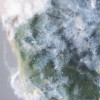 Woolly oak aphids are conspicuous pests on oak, because they are covered with large amounts of flocculent wax. Two genera of woolly oak aphids occur in Florida, each including one known native Florida species. One species, Stegophylla brevirostris Quednau, is common, and the other, Diphyllaphis microtrema Quednau, is rare. This 3-page fact sheet was written by Susan E. Halbert, and published by the UF Department of Entomology and Nematology, October 2013.
Woolly oak aphids are conspicuous pests on oak, because they are covered with large amounts of flocculent wax. Two genera of woolly oak aphids occur in Florida, each including one known native Florida species. One species, Stegophylla brevirostris Quednau, is common, and the other, Diphyllaphis microtrema Quednau, is rare. This 3-page fact sheet was written by Susan E. Halbert, and published by the UF Department of Entomology and Nematology, October 2013.
http://edis.ifas.ufl.edu/in1011
Category: Ecosystems & Species
Native and Nonnative Crocodilians of Florida
 Florida has two native species of crocodilians, the American alligator and the American crocodile. These federally protected species are easily confused with nonnative crocodilians found in south Florida, such as the spectacled caiman and the Nile crocodile. Some key features used to distinguish these animals are the shape of the head, the shape of the snout, and the pattern of nuchal scutes (bony plates in between head and shoulders). It is important to report all nonnative crocodilians so that researchers may quickly remove them in order to protect Florida’s native ecosystems. This 2-page fact sheet was written by Michiko A. Squires, Seth C. Farris, Brian M. Jeffery, and Frank J. Mazzotti, and published by the UF Department of Wildlife Ecology and Conservation, September 2013.
Florida has two native species of crocodilians, the American alligator and the American crocodile. These federally protected species are easily confused with nonnative crocodilians found in south Florida, such as the spectacled caiman and the Nile crocodile. Some key features used to distinguish these animals are the shape of the head, the shape of the snout, and the pattern of nuchal scutes (bony plates in between head and shoulders). It is important to report all nonnative crocodilians so that researchers may quickly remove them in order to protect Florida’s native ecosystems. This 2-page fact sheet was written by Michiko A. Squires, Seth C. Farris, Brian M. Jeffery, and Frank J. Mazzotti, and published by the UF Department of Wildlife Ecology and Conservation, September 2013.
http://edis.ifas.ufl.edu/uw380
Key to Common Bay Trees of Florida
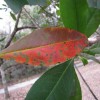 Bay trees in Florida can be difficult to distinguish because their leaves all look alike at first glance. The leaves of bays are all simple, large, elliptical, and evergreen. In addition, several bay species grow in overlapping ranges and habitats. Many times two or more different species of bay will be found growing right next to one other. This 7-page fact sheet includes a dichotomous key to help in the identification of common bay trees found in Florida. A basic description and photos of each species help with the identification process. Written by Lynn Proenza and Michael Andreu, and published by the UF Department of School of Forest Resources and Conservation, September 2013.
Bay trees in Florida can be difficult to distinguish because their leaves all look alike at first glance. The leaves of bays are all simple, large, elliptical, and evergreen. In addition, several bay species grow in overlapping ranges and habitats. Many times two or more different species of bay will be found growing right next to one other. This 7-page fact sheet includes a dichotomous key to help in the identification of common bay trees found in Florida. A basic description and photos of each species help with the identification process. Written by Lynn Proenza and Michael Andreu, and published by the UF Department of School of Forest Resources and Conservation, September 2013.
http://edis.ifas.ufl.edu/fr379
Spotted cucumber beetle Diabrotica undecimpunctata howardi Barber (Insecta: Coleoptera: Chrysomelidae)
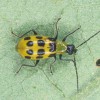 Spotted cucumber beetle is a major agricultural pest of North America. Another name for the spotted cucumber beetle is “southern corn rootworm”. Many Diabrotica species cause damage to field crops, especially corn, making these beetles a major agricultural concern. Because of the subterranean nature of their larvae, these insects are hard and expensive to control. This 6-page fact sheet was written by Harsimran Kaur Gill, Gaurav Goyal, and Jennifer Gillett-Kaufman, and published by the UF Department of Entomology and Nematology, September 2013.
Spotted cucumber beetle is a major agricultural pest of North America. Another name for the spotted cucumber beetle is “southern corn rootworm”. Many Diabrotica species cause damage to field crops, especially corn, making these beetles a major agricultural concern. Because of the subterranean nature of their larvae, these insects are hard and expensive to control. This 6-page fact sheet was written by Harsimran Kaur Gill, Gaurav Goyal, and Jennifer Gillett-Kaufman, and published by the UF Department of Entomology and Nematology, September 2013.
http://edis.ifas.ufl.edu/in1008
Overwintering Honey Bee Colonies in Northern Climates
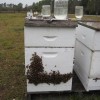 One of the many challenges beekeepers face is minimizing honey bee colony losses during winter. This can be especially challenging to beekeepers in extreme northerly climates. Special preparations must be made during the fall to ensure that colonies survive the winter months with minimal loss. This 3-page fact sheet was written by James D. Ellis and Katherine Hammons, and published by the UF Department of Entomology and Nematology, September 2013.
One of the many challenges beekeepers face is minimizing honey bee colony losses during winter. This can be especially challenging to beekeepers in extreme northerly climates. Special preparations must be made during the fall to ensure that colonies survive the winter months with minimal loss. This 3-page fact sheet was written by James D. Ellis and Katherine Hammons, and published by the UF Department of Entomology and Nematology, September 2013.
http://edis.ifas.ufl.edu/in1006
Rat lungworm Angiostrongylus cantonensis (Chen, 1935) (Nematoda: Strongylida: Metastrongylida)
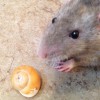 Like many pest and disease problems, rat lungworm has been slowly spreading around the world. First described by Chen from rats in China, the medical significance of this parasite was overlooked until 1944 when it was found infecting humans in Taiwan. Even then, because the report was published in Japanese, its importance remained largely unknown. In 1955, Mackerras and Sandars found this nematode among rats in Brisbane, Australia, and described its life cycle, including the importance of its molluscan intermediate hosts. This 4-page fact sheet was written by John Capinera and Heather S. Walden, and published by the UF Department of Entomology and Nematology, September 2013.
Like many pest and disease problems, rat lungworm has been slowly spreading around the world. First described by Chen from rats in China, the medical significance of this parasite was overlooked until 1944 when it was found infecting humans in Taiwan. Even then, because the report was published in Japanese, its importance remained largely unknown. In 1955, Mackerras and Sandars found this nematode among rats in Brisbane, Australia, and described its life cycle, including the importance of its molluscan intermediate hosts. This 4-page fact sheet was written by John Capinera and Heather S. Walden, and published by the UF Department of Entomology and Nematology, September 2013.
http://edis.ifas.ufl.edu/in1007
Eriophyid mite vector of Rose Rosette Disease (RRD) Phyllocoptes fructiphilus Keifer (Arachnida: Acari: Eriophyidae)
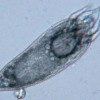 Phyllocoptes fructiphilus Keifer, a tiny eriophyid mite, is the vector of a devastating viral disease of roses called Rose Rosette Disease (RRD). This mite can be spread by the wind and by contaminated clothing and equipment. It also is possible that it can disperse through phoresy (attaching itself to insects). As a result, the distribution of the mite and RRD is expanding. This 5-page fact sheet was written by Marjorie Hoy, and published by the UF Department of Entomology and Nematology, May 2013.
Phyllocoptes fructiphilus Keifer, a tiny eriophyid mite, is the vector of a devastating viral disease of roses called Rose Rosette Disease (RRD). This mite can be spread by the wind and by contaminated clothing and equipment. It also is possible that it can disperse through phoresy (attaching itself to insects). As a result, the distribution of the mite and RRD is expanding. This 5-page fact sheet was written by Marjorie Hoy, and published by the UF Department of Entomology and Nematology, May 2013.
http://edis.ifas.ufl.edu/in999
Southern black widow Latrodectus mactans (Fabricius) (Arachnida: Araneae: Theridiidae)
 The Southern black widow spider, Latrodectus mactans (Fabricius), is a venomous spider found throughout the southeastern United States. Widow spiders received their name from the belief that they would kill and consume their mate following copulation. However, the practice was mainly observed in laboratory settings under crowded conditions. It is believed that sexual cannibalism within the widow species in natural settings is more associated with the male’s physical inability to escape rather than the female’s interest in consuming him. This 6-page fact sheet was written by Amanda Eiden and Phil E. Kaufman, and published by the UF Department of Entomology and Nematology, May 2013.
The Southern black widow spider, Latrodectus mactans (Fabricius), is a venomous spider found throughout the southeastern United States. Widow spiders received their name from the belief that they would kill and consume their mate following copulation. However, the practice was mainly observed in laboratory settings under crowded conditions. It is believed that sexual cannibalism within the widow species in natural settings is more associated with the male’s physical inability to escape rather than the female’s interest in consuming him. This 6-page fact sheet was written by Amanda Eiden and Phil E. Kaufman, and published by the UF Department of Entomology and Nematology, May 2013.
http://edis.ifas.ufl.edu/in1000
Phoenix canariensis: Canary Island Date Palm
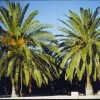 The Canary Island date palm is native to the Canary Islands. Although it can reach heights of 40–50 feet, it is slow growing and requires many years to attain that height. It has 8- to 15-foot-long rigid leaves that contain up to 200 V-shaped leaflets, the basal ones of which are modified into long, sharp spines. Leaves are not self-cleaning and must be manually removed when dead, but the leaf bases eventually rot off, leaving an attractive diamond-shaped pattern of leaf scars on the 2- to 3-foot-diameter trunk. On older specimens, the basal foot or so of the trunk typically is covered with short root initials. This 6-page fact sheet was written by T. K. Broschat, and published by the UF Department of Environmental Horticulture, August 2013.
The Canary Island date palm is native to the Canary Islands. Although it can reach heights of 40–50 feet, it is slow growing and requires many years to attain that height. It has 8- to 15-foot-long rigid leaves that contain up to 200 V-shaped leaflets, the basal ones of which are modified into long, sharp spines. Leaves are not self-cleaning and must be manually removed when dead, but the leaf bases eventually rot off, leaving an attractive diamond-shaped pattern of leaf scars on the 2- to 3-foot-diameter trunk. On older specimens, the basal foot or so of the trunk typically is covered with short root initials. This 6-page fact sheet was written by T. K. Broschat, and published by the UF Department of Environmental Horticulture, August 2013.
http://edis.ifas.ufl.edu/st439
Rainbow scarab Phaneaus vindex Macleay (Insecta: Coleoptera: Scarabaeidae)
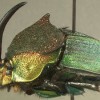 Rainbow scarabs are members of the beetle family Scarabaeidae, which along with the family Geotrupidae, are commonly known as dung beetles. Scarab beetles were the objects of worship in Ancient Egypt and the more spectacular varieties are made into jewelry. The genus Phanaeus MacLeay is distributed primarily in Neotropical habitats with 100 species, but also in the Neartic region with nine species and the West Indies with one. Dung beetles serve an important role in pasture ecosystems, which has resulted in their introduction around the world. The rainbow scarab has a bright exterior of metallic green, blue, and red interspersed with golden reflections. This 5-page fact sheet was written by Thomson Paris, Barukh Rohde, and Philip E. Kaufman, and published by the UF Department of Entomology and Nematology, July 2013.
Rainbow scarabs are members of the beetle family Scarabaeidae, which along with the family Geotrupidae, are commonly known as dung beetles. Scarab beetles were the objects of worship in Ancient Egypt and the more spectacular varieties are made into jewelry. The genus Phanaeus MacLeay is distributed primarily in Neotropical habitats with 100 species, but also in the Neartic region with nine species and the West Indies with one. Dung beetles serve an important role in pasture ecosystems, which has resulted in their introduction around the world. The rainbow scarab has a bright exterior of metallic green, blue, and red interspersed with golden reflections. This 5-page fact sheet was written by Thomson Paris, Barukh Rohde, and Philip E. Kaufman, and published by the UF Department of Entomology and Nematology, July 2013.
http://edis.ifas.ufl.edu/in1003
Swirski mite (suggested common name) Amblyseius swirskii Athias-Henriot (Arachnida: Mesostigmata: Phytoseiidae)
 Amblyseius is a beneficial predatory mite endemic to the Eastern Mediterranean region. This species is considered a generalist predator, and readily consumes small soft-bodied pest species as well as pollen or plant exudates. Amblyseius swirskii has attracted substantial interest as a biological control agent of mites, thrips and whiteflies in greenhouse and nursery crops and is currently reared and sold commercially in Europe and North America for this purpose. This 5-page fact sheet was written by Mahmut Dogramaci, Garima Kakkar, Vivek Kumar, Jianjun Chen, and Steven Arthurs, and published by the UF Department of Entomology and Nematology, June 2013.
Amblyseius is a beneficial predatory mite endemic to the Eastern Mediterranean region. This species is considered a generalist predator, and readily consumes small soft-bodied pest species as well as pollen or plant exudates. Amblyseius swirskii has attracted substantial interest as a biological control agent of mites, thrips and whiteflies in greenhouse and nursery crops and is currently reared and sold commercially in Europe and North America for this purpose. This 5-page fact sheet was written by Mahmut Dogramaci, Garima Kakkar, Vivek Kumar, Jianjun Chen, and Steven Arthurs, and published by the UF Department of Entomology and Nematology, June 2013.
http://edis.ifas.ufl.edu/in1001
Seedcorn maggot, Delia platura (Meigen) (Insecta: Diptera: Anthomyiidae)
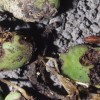 The seedcorn maggot is a polyphagous pest, affecting more than 40 different host plants. It is an important pest of germinating soybeans and corn, and also attacks a wide range of horticultural crops including beans, peas, cucumber, melon, onion, pepper, potato, and other vegetables. Seedcorn maggots damage newly planted seeds by feeding on seed contents, often leaving empty seed shells and preventing germination. Although usually no more than 2% of the seedlings get infested by this insect, 30% to 60% plant loss may occur in the field. This 5-page fact sheet was written by Harsimran Kaur Gill, Gaurav Goyal, and Jennifer L. Gillett-Kaufman, and published by the UF Department of Entomology and Nematology, July 2013.
The seedcorn maggot is a polyphagous pest, affecting more than 40 different host plants. It is an important pest of germinating soybeans and corn, and also attacks a wide range of horticultural crops including beans, peas, cucumber, melon, onion, pepper, potato, and other vegetables. Seedcorn maggots damage newly planted seeds by feeding on seed contents, often leaving empty seed shells and preventing germination. Although usually no more than 2% of the seedlings get infested by this insect, 30% to 60% plant loss may occur in the field. This 5-page fact sheet was written by Harsimran Kaur Gill, Gaurav Goyal, and Jennifer L. Gillett-Kaufman, and published by the UF Department of Entomology and Nematology, July 2013.
http://edis.ifas.ufl.edu/in1002
Granulate cutworm, Feltia subterranea (Fabricius) (Insecta: Lepidoptera: Noctuidae)
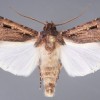 The granulate cutworm, Feltia subterranea (Fabricius) is the most commonly occurring cutworm in Florida, though it is rarely numerous enough to be a major pest. It is nocturnal through most of its life, and lacks distinctive features in the larval and adult stage, so it often is overlooked, and its activities and damage are not fully appreciated. This 4-page fact sheet was written by John L. Capinera, and published by the UF Department of Entomology and Nematology, May 2013.
The granulate cutworm, Feltia subterranea (Fabricius) is the most commonly occurring cutworm in Florida, though it is rarely numerous enough to be a major pest. It is nocturnal through most of its life, and lacks distinctive features in the larval and adult stage, so it often is overlooked, and its activities and damage are not fully appreciated. This 4-page fact sheet was written by John L. Capinera, and published by the UF Department of Entomology and Nematology, May 2013.
http://edis.ifas.ufl.edu/in997
Scarlet-bodied wasp moth, Cosmosoma myrodora (Dyar) (Insecta: Lepidoptera: Arctiidae)
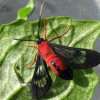 The scarlet-bodied wasp moth, Cosmosoma myrodora (Dyar), is a beautiful native insect. Because of its striking adult coloration, including a bright red thorax and abdomen, and transparent wings patterned with black, this moth immediately stands out in Florida landscapes. Larval feeding is restricted to two native plants in the genus Mikania, family Asteraceae. This 5-page fact sheet was written by Diego Moscoso, Rodrigo Diaz, and William A. Overholt, and published by the UF Department of Entomology and Nematology, May 2013.
The scarlet-bodied wasp moth, Cosmosoma myrodora (Dyar), is a beautiful native insect. Because of its striking adult coloration, including a bright red thorax and abdomen, and transparent wings patterned with black, this moth immediately stands out in Florida landscapes. Larval feeding is restricted to two native plants in the genus Mikania, family Asteraceae. This 5-page fact sheet was written by Diego Moscoso, Rodrigo Diaz, and William A. Overholt, and published by the UF Department of Entomology and Nematology, May 2013.
http://edis.ifas.ufl.edu/in996
Olive shootworm, Palpita persimilis Munroe (Insecta: Lepidoptera: Crambidae)
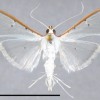 Palpita persimilis Munroe (Lepidoptera: Crambidae) is a defoliator of olives and privet in South America. Examination of specimens submitted to UF-IFAS and FDACS-DPI prompted the discovery that the species has been established in Florida for many years, having been confused with two similar native species. The confusion parallels historical misidentifications in Peru. To date, all vouchered specimens in Florida with host information were found feeding on leaves of Ligustrum japonicum Thunb. (Japanese privet). This 6-page fact sheet was written by James E. Hayden and Lyle J. Buss, and published by the UF Department of Entomology and Nematology, May 2013.
Palpita persimilis Munroe (Lepidoptera: Crambidae) is a defoliator of olives and privet in South America. Examination of specimens submitted to UF-IFAS and FDACS-DPI prompted the discovery that the species has been established in Florida for many years, having been confused with two similar native species. The confusion parallels historical misidentifications in Peru. To date, all vouchered specimens in Florida with host information were found feeding on leaves of Ligustrum japonicum Thunb. (Japanese privet). This 6-page fact sheet was written by James E. Hayden and Lyle J. Buss, and published by the UF Department of Entomology and Nematology, May 2013.
http://edis.ifas.ufl.edu/in995
The Asiatic garden beetle Maladera castanea (Arrow 1913) (Coleoptera: Scarabaeidae)
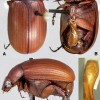 The Asiatic garden beetle has been a pest in the northeastern United States since the 1920s. Generally not as abundant or damaging as the Japanese beetle, this pest beetle is occasionally numerous enough to cause damage to turf, gardens and field crops, as well as simply being a nuisance. It’s discovery in Florida was not unexpected. This is the first report of this pest beetle in the lower southeastern U.S. coastal plain. This 3-page fact sheet was written by Paul E. Skelley, and published by the UF Department of Entomology and Nematology, April 2013.
The Asiatic garden beetle has been a pest in the northeastern United States since the 1920s. Generally not as abundant or damaging as the Japanese beetle, this pest beetle is occasionally numerous enough to cause damage to turf, gardens and field crops, as well as simply being a nuisance. It’s discovery in Florida was not unexpected. This is the first report of this pest beetle in the lower southeastern U.S. coastal plain. This 3-page fact sheet was written by Paul E. Skelley, and published by the UF Department of Entomology and Nematology, April 2013.
http://edis.ifas.ufl.edu/in992
A Cooperative Agreement and the Implementation of the Endangered Species Act: How Extension Can Facilitate Stakeholder Involvement and Compliance
 This 4-page fact sheet provides a brief description of the Endangered Species Act and updated action pertaining to the endangered species issue. The goal of this publication is to provide brief but clear information about the legislation and current agreements around this issue that Extension agents can use to increase educated conversations. Written by Chandra Bowden, Alexa Lamm, Tracy Irani, and Sebastian Galindo, and published by the UF Department of Agricultural Education and Communication, May 2013.
This 4-page fact sheet provides a brief description of the Endangered Species Act and updated action pertaining to the endangered species issue. The goal of this publication is to provide brief but clear information about the legislation and current agreements around this issue that Extension agents can use to increase educated conversations. Written by Chandra Bowden, Alexa Lamm, Tracy Irani, and Sebastian Galindo, and published by the UF Department of Agricultural Education and Communication, May 2013.
http://edis.ifas.ufl.edu/wc141
Palm Morphology and Anatomy
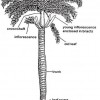 Palms differ greatly from broadleaf (dicot) and coniferous (Gymnosperm) trees in their overall form and external structure (morphology) and in their internal structure (anatomy). Morphology and anatomy determine how palms grow, function, and respond to external and internal stress factors. This publication provides a basic understanding of how palms are constructed. This 4-page fact sheet was written by T. K. Broschat, and published by the UF Department of Environmental Horticulture, May2013.
Palms differ greatly from broadleaf (dicot) and coniferous (Gymnosperm) trees in their overall form and external structure (morphology) and in their internal structure (anatomy). Morphology and anatomy determine how palms grow, function, and respond to external and internal stress factors. This publication provides a basic understanding of how palms are constructed. This 4-page fact sheet was written by T. K. Broschat, and published by the UF Department of Environmental Horticulture, May2013.
http://edis.ifas.ufl.edu/ep473
Eastern dobsonfly (adult), hellgrammite (larva) Corydalus cornutus (Linnaeus) (Insecta: Megaloptera: Corydalidae: Corydalinae) (EENY414/IN987)
 The eastern dobsonfly is one of our largest non-lepidopteran insects. Its larvae, known as hellgrammites, are the top invertebrate predators in rocky streams where they occur. Adult male dobsonflies are particularly spectacular because of their large sickle-shaped mandibles (jaws). This 4-page fact sheet was written by Donald W. Hall, and published by the UF Department of Entomology and Nematology, April 2013.
The eastern dobsonfly is one of our largest non-lepidopteran insects. Its larvae, known as hellgrammites, are the top invertebrate predators in rocky streams where they occur. Adult male dobsonflies are particularly spectacular because of their large sickle-shaped mandibles (jaws). This 4-page fact sheet was written by Donald W. Hall, and published by the UF Department of Entomology and Nematology, April 2013.
http://edis.ifas.ufl.edu/in987
A Mealybug Phenacoccus multicerarii Granara de Willink (Hemiptera: Pseudococcidae) (EENY550/IN993)
 Florida Department of Agriculture and Consumer Services, Division of Plant Industry inspector Lisa Hassell collected the mealybug Phenacoccus multicerarii, a new continental record, from a retail nursery in Fernandina Beach (Nassau County, on 15 June 2011). On a return visit to the store, the mealybug was observed in high numbers on numerous host plants. Three days later, an additional find was made at a nursery in Apopka that had exchanged plant material with the nursery in Jacksonville. No further infestations were reported until October 2012, when a heavy infestation was discovered on a residential planting of coleus in Cooper City (Broward County). This mealybug was described in 2007 from a sample collected in Caracas, Venezuela, in 1949 from an unknown host (Granara de Willink and Szumik 2007). This 2-page fact sheet was written by Ian Stocks, and published by the UF Department of Entomology and Nematology, April 2013.
Florida Department of Agriculture and Consumer Services, Division of Plant Industry inspector Lisa Hassell collected the mealybug Phenacoccus multicerarii, a new continental record, from a retail nursery in Fernandina Beach (Nassau County, on 15 June 2011). On a return visit to the store, the mealybug was observed in high numbers on numerous host plants. Three days later, an additional find was made at a nursery in Apopka that had exchanged plant material with the nursery in Jacksonville. No further infestations were reported until October 2012, when a heavy infestation was discovered on a residential planting of coleus in Cooper City (Broward County). This mealybug was described in 2007 from a sample collected in Caracas, Venezuela, in 1949 from an unknown host (Granara de Willink and Szumik 2007). This 2-page fact sheet was written by Ian Stocks, and published by the UF Department of Entomology and Nematology, April 2013.
http://edis.ifas.ufl.edu/in993